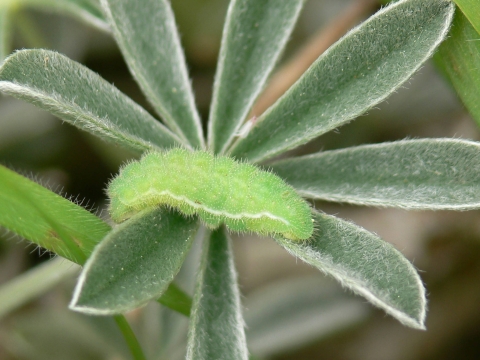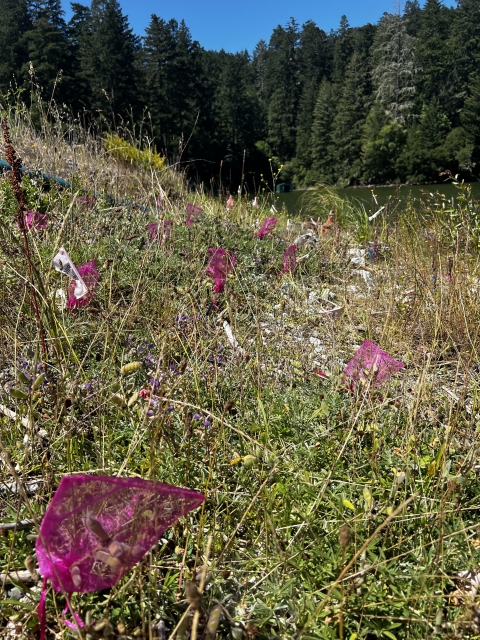Unlike the story of the Very Hungry Caterpillar who ate through fruit, cake and other treats before turning into a butterfly, some caterpillars are very picky eaters, including the mission blue butterfly caterpillars.
Biologists from the Sacramento Fish and Wildlife Office went out to the San Francisco Public Utilities Commission Peninsula Watershed with Commission staff to collect seeds of summer lupine (Lupinus formosus), one of three native lupine species that feeds the caterpillar of the mission blue butterfly.
“The goal of this project is to collect seeds from the lupine and grow plants to be used in habitat restoration projects to support the butterfly’s recovery,” said Emilie Graves, a biologist from the SFWO’s Listing and Recovery Division.
The mission blue butterfly is found at just a few undeveloped sites in Marin, San Francisco and San Mateo counties. The National Park Service (NPS) is the lead agency on the seed collection effort and manages Golden Gate National Recreation Area (GGNRA), an important location for the butterflies. GGNRA recently received funding from the Bipartisan Infrastructure Law Bipartisan Infrastructure Law
The Bipartisan Infrastructure Law (BIL) is a once-in-a-generation investment in the nation’s infrastructure and economic competitiveness. We were directly appropriated $455 million over five years in BIL funds for programs related to the President’s America the Beautiful initiative.
Learn more about Bipartisan Infrastructure Law to restore grasslands and is dedicating some of that funding on the expansion of lupine populations to support the butterfly.
NPS partnered with the San Francisco Public Utilities Commission to collect seeds from the Commission’s 23,000-acre watershed lands on the San Francisco Peninsula.
“To catch the seeds, we tied bags over the developing lupine seed pods, but it will still be a few weeks before the pods open,” said Graves, who joined the Commission in the field.
As the pods mature and open, the seeds will drop into the bags. The Golden Gate National Parks Conservancy will prepare the seeds at one of their native plant nurseries and then send the seeds to Heritage Growers outside Davis, California. Heritage Growers will grow the seeds in small plots of land and establish the resulting plants into a managed seed source. The process, known as seed amplification, will be supported for at least five years.
Seeds collected from these plots will be shared with partners across the mission blue butterfly’s range in GGNRA, sites managed by San Mateo County Parks and the San Francisco Public Utilities Commission Peninsula Watershed. They will plant the seeds to create a new food source for the caterpillars so the butterflies can expand their range.
“The number of groups working together to increase the lupines available for the mission blue butterfly really shows how invaluable partnerships are for conservation work,” said Graves. “Everyone is working to recover the mission blue butterfly.”







